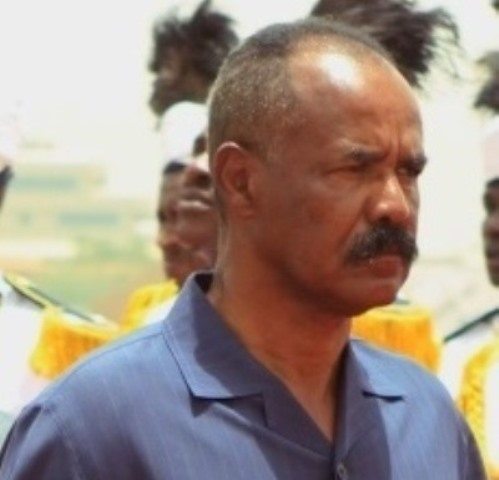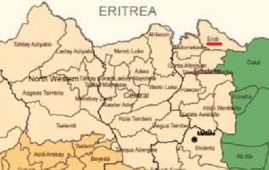HORN OF AFRICA – DROUGHT
FACT SHEET #4, FISCAL YEAR (FY) 2012
Oct. 27, 2011
During the week of October 24, fighting continued between the Somalia Transitional Federal Government, supported by the African Union Mission in Somalia, and al-Shabaab in Somalia. In addition, the Government of Kenya (GoK) continues to target al-Shabaab forces in Somalia. According to the U.N. Office for the Coordination of Humanitarian Affairs (OCHA), the escalation in military activities is leading to further displacement of already displaced populations in Somalia. Fighting and increased insecurity, including recent events impacting humanitarian organizations, may result in decreased humanitarian space and operations in areas affected by the fighting.
The Office of the U.N. High Commissioner for Refugees (UNHCR) reported that the number of Somali refugees crossing the Somalia−Kenya border decreased to 100 people between October 17 and 23, representing a decline from the 3,400 people who crossed the border during the previous week. UNHCR attributes the decline in new arrivals in Kenya to increasing military tensions in border areas and the onset of heavy rains. UNHCR notes that the number of Somalis crossing into Ethiopia has increased, with nearly 5,000 people crossing the Somalia−Ethiopia border during the first half of October, raising the daily arrival rate to 414 people or more than twice the September trend.
On October 24, U.S. Secretary of State Hillary Rodham Clinton announced that the U.S. Government (USG) is providing more than $100 million in additional humanitarian assistance to Ethiopia, Kenya, and Somalia, bringing total USG humanitarian assistance to the region to more than $750 million in FY 2011 and FY 2012 to date. The additional assistance includes funding from USAID’s Office of U.S. Foreign Disaster Assistance (USAID/OFDA) for economic recovery and market systems and water, sanitation, and hygiene (WASH) interventions and logistics and relief commodities in Somalia. USAID’s Office of Food for Peace (USAID/FFP) is providing additional food assistance for affected populations in Kenya, Ethiopia, and Somalia. As of October 27, the majority of FY 2011 USAID/OFDA- and USAID/FFP-funded drought-response activities remain ongoing.
NUMBERS AT A GLANCE
People Requiring Humanitarian Assistance
-
in Kenya 4.3 million (Includes refugees). Source: OCHA – September 8, 2011
-
in Ethiopia 4.8 million (Includes refugees, except for 20,000 to 25,000 new Sudanese refugees in western Ethiopia). Source: OCHA – September 8, 2011
-
in Somalia 4.0 million. Source: OCHA – September 8, 2011
-
in Djibouti 165,642. Source: OCHA – September 8, 2011
-
Number of Somali Refugees in Kenya 519,764. Source: UNHCR – October 27, 2011
-
Number of Somali Refugees in Ethiopia 177,201. Source: UNHCR – October 27, 2011
-
Number of Somali Refugees in Djibouti 18,159. Source: UNHCR – October 27, 2011
FY 2012 HUMANITARIAN FUNDING
[Includes funding to Ethiopia, Kenya, and Somalia]
-
USAID/OFDA Assistance to the Horn of Africa $2,558,052
-
USAID/FFP Assistance to the Horn of Africa $100,900,000
-
Total USAID Assistance to the Horn of Africa $103,458,052
FY 2011 HUMANITARIAN FUNDING
[Includes funding to Djibouti, Ethiopia, Kenya, and Somalia]
-
USAID/OFDA Assistance to the Horn of Africa $108,584,187
-
USAID/FFP Assistance to the Horn of Africa $435,193,274
-
State/PRM Assistance to the Horn of Africa $106,741,455 [State/PRM is an abbr. of U.S. Department of State’s Bureau of Population, Refugees, and Migration]
-
Total USAID and State Assistance to the Horn of Africa $650,518,916
Context
Following below-average 2011 spring rains in the eastern Horn of Africa, food security among pastoralists and populations in marginal farming areas sharply deteriorated. In addition to below-normal harvests, shortages of grazing resources for livestock have resulted in abnormal migrations, with pastoralists travelling long distances in search of pasture and water, according to OCHA.
In Somalia, the U.N. has declared that acute malnutrition indicators, crude mortality rates, and food access levels have surpassed famine thresholds in areas of Bay, Lower Shabelle, Bakool, and Middle Shabelle regions, and among internally displaced persons (IDPS) in Mogadishu and the Afgooye corridor. Without improvement in humanitarian access, famine is expected to spread to other areas of Gedo, Juba, and Hiran regions by December 2011, according to USAID’s Famine Early Warning Systems Network (FEWS NET).
On October 13, 2011, U.S. Ambassador James C. Swan, Special Representative for Somalia in Nairobi, Kenya, renewed the disaster declaration for the complex emergency in Somalia for FY 2012. On October 19, 2011, U.S. Ambassador Donald E. Booth reissued the disaster declaration in response to the ongoing complex emergency in Ethiopia. On January 28, 2011, U.S. Ambassador Michael E. Ranneberger declared a disaster due to the effects of the drought in Kenya.
In response, the USG immediately increased assistance to affected areas of Ethiopia, Kenya, and Somalia. On July 6, 2011, USAID activated a regional Disaster Assistance Response Team (USAID/DART) in Nairobi, Kenya, and Addis Ababa, Ethiopia, to monitor regional drought conditions, identify humanitarian needs, and coordinate response activities with other donors. USAID also stood up a Response Management Team in Washington, D.C., to support the USAID/DART and coordinate USG humanitarian efforts.
Emergency Food Assistance, Food Security, and Livelihoods
The October to December deyr or short rains have begun on time in most areas of the eastern Horn of Africa, including parts of southern Somalia and southern and southeastern Ethiopia. The rains have begun early in the coastal, pastoral, and southeastern cropping lowlands of Kenya, according to FEWS NET.
Ethiopia
-
The Government of Ethiopia National Meteorological Agency and FEWS NET forecast near-normal to below- normal October to December rains throughout southern and southeastern pastoralist and agro-pastoralist areas of Ethiopia due to the weak reemergence of the La Niña weather event. In addition, FEWS NET has indicated that the October to December rains may cease earlier than expected. Relief agencies note that the performance of the October to December rains will determine the food security situation for pastoral and lowland areas of Ethiopia during the coming months. Despite the outcome of the current rains, a single rainy season will not be sufficient to initiate full recovery from years of prolonged drought in Ethiopia’s affected areas.
-
FEWS NET expects seasonal improvements in the availability of water and browse for camels, goats, and sheep as a result of the October to December rains in southern and southeastern pastoralist and agro-pastoralist areas; however, FEWS NET notes that pasture will not fully regenerate after one rainy season.
-
In FY 2012 to date, USAID/FFP has provided $52 million to support affected populations in Ethiopia, including $26 million to distribute more than 42,260 metric tons (MT) of food supplies to individuals in Ethiopia’s drought-affected areas.
Kenya
-
During September, the U.N. World Food Program (WFP) provided food or cash assistance to 989,025 people— nearly 45 percent of the population targeted for WFP food and cash assistance activities during September. OCHA reports that operational challenges, including food quality issues and shipment delays, hindered WFP’s efforts to reach populations in areas. Due to operational challenges, WFP distributions were not carried out in Malindi, Kilifi, East Pokot, Tana River, and South Turkana districts.
-
WFP reports that rising fuel and food prices during 2011 have increased inflation to record highs, with September inflation levels reaching 17.3 percent. The inflation has most affected poor households as they spend a larger share of income on food. Maize prices in pastoral areas of Turkana, Mandera, and Marsabit counties increased due to the high transaction cost of transporting maize to pastoral areas. However, maize prized decreased by 50 percent in Turkana South District due to an above-average harvest.
-
In FY 2012 to date, USAID/FFP has provided $12 million to support WFP efforts to address immediate food needs across Kenya. USAID/FFP funding is supporting the distribution of 3,940 MT of food rations to drought-affected individuals and more than 6,230 MT of food supplies to refugees.
Somalia
-
As of October 24, areas of southern Somalia—including Bakool, Banadir, Bay, Gedo, Lower Juba, and Lower Shabelle regions—had received heavy rainfall, with reports of flooding in Gedo and Lower Juba regions. Although the rains may improve water availability and promote the recovery of pasture and browse, they also raise the risk of increased morbidity and mortality among already weakened populations. The U.N. Food and Agriculture Organization’s (FAO) Somali Water and Land Management Unit forecasts that heavy rains will continue during the coming weeks.
-
Between October 1 and 24, humanitarian agencies reached 893,000 beneficiaries through food assistance activities, including wet feeding programs, food distributions, and cash and voucher distributions. The majority of the 2.2. million beneficiaries reached through food assistance programs in September were located in southern Somalia. In addition, OCHA reports that the Organization of Islamic Cooperation and partners have reached 1.4 million beneficiaries since April, with 40 percent of the total reached residing in Mogadishu.
-
The onset of the October to December rains has led to worsening road conditions in areas receiving heavy rainfall, impacting the delivery of humanitarian assistance to Gedo, Middle Juba, and Bay regions. OCHA also reports that the Food Cluster, the coordinating body for food-related activities in Somalia, conducted a gap analysis in September and found a significant gap in food assistance programs in Middle Shabelle, Lower Juba, and Galgadud regions.
-
In FY 2012, USAID/FFP has provided nearly $37 million to Somalia for emergency food assistance. In addition, USAID/OFDA has provided approximately more than $900,000 in FY 2012 to date for economic recovery and market systems programs aimed at improving the food security and livelihoods of 16,400drought-affected individuals. In addition, USAID/OFDA and USAID/FFP FY 2011 initiatives remain ongoing throughout affected areas of Somalia.
Health, Nutrition, and WASH
Ethiopia
-
The Government of Ethiopia began a national emergency measles campaign at the end of September, targeting 6.9 million children between the ages of six months and 15 years in six regions of Ethiopia. As of October 10, the campaign had vaccinated nearly 313,000 children in the Somali Region, representing 91 percent of the total children targeted in high-risk districts in the region.
-
OCHA reports that the onset of the October to December rains has reduced the overall water trucking requirement in Ethiopia. Between October 12 and 19, the overall need for water trucking decreased to 78 trucks nationally—a reduction of 79 trucks from the early October requirement. Although water trucking does not provide a long-term solution to water needs, humanitarian partners continue to support water trucking in areas where sustainable water supplies remain unavailable or limited. The U.N. Children’s Fund (UNICEF) reports that 73 water trucks were operational nationwide as of October 19.
-
During FY 2011, USAID/OFDA provided more than $9.8 million to support two rapid response programs in Ethiopia focused on addressing emergency nutrition and WASH needs. USAID/OFDA’s flexible rapid response capacity allows for the rapid scale up of activities in the event of an emergency, such as the current drought. Through a rapid response program with GOAL, humanitarian partners expanded activities that address nutritional needs in drought-affected areas. In addition, through the International Rescue Committee (IRC) WASH rapid response program, partners have provided safe drinking water through water point rehabilitation and water trucking to drought-affected communities.
Kenya
-
As of October 24, OCHA reported more than 10,000 suspected cases of dengue fever in Mandera County. The GoK Ministry of Health and U.N. World Health Organization (WHO) have confirmed 1,289 cases since September 21. The GoK and partners are responding through household-level surveillance and case management, including fogging, larviciding, and indoor residual spraying. The U.S. Centers for Disease Control and Surveillance are a conducting vector analysis for the virus.
-
Areas of northwestern Kenya, including Turkana County, are experiencing an increase in the number of malaria cases following recent rains and flooding. According to UNICEF, more than 1,700 malaria cases have been reported at Kakuma refugee camp since September 1, approximately 86 percent of the total 2011 caseload of 2,052 cases. The GoK and UNICEF have pre-positioned antimalarial medication for health facilities operating in drought-affected areas of Kenya.
-
Since July, UNICEF has treated more than 11,900 children suffering from severe acute malnutrition (SAM) in drought-affected areas of Kenya, representing 49 percent of the malnourished children targeted for treatment between July and December. According to OCHA, nutrition partners are currently treating 18,773 children with SAM through outpatient therapeutic programs. In addition, OCHA reports that partners are treating 67,374 children with moderate acute malnutrition through supplementary feeding programs throughout Kenya.
Somalia
-
Although rains continue to replenish depleted water sources in southern Somalia, heavy rainfall also increases the susceptibility of weakened populations to acute water diarrhea (AWD) and other waterborne diseases. WHO notes that the large IDP influx into urban areas, combined with increases in the number of informal settlements, poor sanitation conditions, and a lack of access to safe drinking water, may increase the risk of transmission and major outbreaks of waterborne diseases.
-
As of October 25, the Health Cluster, the coordinating body for health-related activities in Somalia, reported suspected AWD cases in areas of Bay and Lower Juba regions and the Hiran IDP camp in southern Gaalkacyo town, Mudug Region. In addition, health partners reported more than 2,800 cases of AWD with 66 related deaths in central and southern areas of Somalia during the first two weeks of October, with more than 1,300 of the cases occurring in Banadir.
-
WHO and health partners have strategically pre-positioned AWD supplies in strategic locations in southern and central Somalia. Health organizations have also provided the Banadir Hospital in Mogadishu with supplies, including oral rehydration salts and intravenous fluids, sufficient to treat up to 500 severe AWD cases. Although humanitarian partners continue to scale up health assistance in Somalia, gaps remain, particularly in access to basic health services. Due to heavy fighting that broke out in Dayniile district, north of Mogadishu, on October 20, a health agency suspended a measles vaccination campaign that was targeting 35,000 children. Although WHO reports a downward trend in reported measles cases in Banadir and Middle Juba regions during recent weeks, WHO has noted an increase in cases in Lower Shabelle Region.
-
USAID/OFDA has provided more than $1.3 million in FY 2012 to date for WASH interventions benefiting more than 49,400 people in affected areas of Somalia. USAID continues to monitor ongoing conditions to determine any additional WASH needs that may arise with the onset of the current rainy season.
[The factsheet does also provide a tabular breakdown of the activities, targeted countries and the implementing partner/NGO of the USAID’s humanitarian assistance plan to the Horn of Africa. You can download USAID’s FY 2012 Horn of Africa drought – Factsheet – here]
Note: The map posted above was not included in the USAID’s factsheet. The map is taken from Oct. 28 report of the United Nations Office for the Coordination of Humanitarian Affairs (OCHA).
*************
Check the Famine archive or hunger archive or Somalia archive for related posts.







1 Comment on this post
Comments are closed.
Leave a Comment